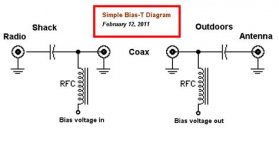yellingsoftly
Member
- Joined
- Mar 22, 2024
- Messages
- 25
Was testing a pair of cheap bias tees like the ones you find on eBay/amazon and so on that others have posted. the first one worked great I can see it’s inserting the proper voltage onto the coax with my multi meter but when I insert the second at the other end of a short coax when testing with the rf+dc port facing away from the antenna towards the other bias tee that is at the receiver I get voltage for a second lower than what’s coming out of the coax but it starts dropping immediately. I’m guessing this tee has a short but thought I would verify I’m using things correctly.
So linear power supply 12 volt 0.5 amp > bias tee with rf + dc port sending power up coax measured at other end of coax at 12 volts > rf+dc port measuring 5 volts at dc port then dropping to near 0 volts after a few seconds of measuring.
So linear power supply 12 volt 0.5 amp > bias tee with rf + dc port sending power up coax measured at other end of coax at 12 volts > rf+dc port measuring 5 volts at dc port then dropping to near 0 volts after a few seconds of measuring.


